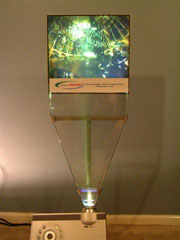Soon everyone will be able to afford to watch television on a large screen. Cambridge Flat Projection Displays (CamFPD) has developed a 20mm thick, 50" screen, which is low cost to produce.

The innovative 'wedge screen' uses internal projection to create a large image on a thin screen. The lack of electronic components across the area of the screen will mean that it will cost a tiny fraction of a plasma or liquid crystal display.
Large screen displays currently use either back projection, which is bulky; or a plasma screen, which requires thousands of high voltage transistors making it difficult and expensive to manufacture.
CamFPD overcomes both these issues. It is a wedge shaped panel of Plexiglass, slightly thicker at the bottom than the top. Light is projected internally within the wedge. As the light bounces off the sides of the wedge, the angle gets bigger through internal reflection until the critical angle is reached and the ray emerges to create an element of the picture.
Dr Adrian Travis, developer of the Wedge Display, believes that the screen will revolutionise the audiovisual market. 'Although the cost of plasma screens has come down it is still a limiting factor for the uptake of associated digital technologies. The Wedge screen is lightweight, portable and has many applications - it can even be used in reverse as a camera for video conferences"
The new screen is also environmentally sound as Plexiglass can be recycled quite easily. This is important as legislation will soon make it compulsory to dispose of old cathode ray tubes, plasma and LCD displays safely, which will require expensive specialist services.
Dr Travis is currently in negotiations with manufacturers in the Far East to bring the screen to mass production. He comments: "There is no limit to the size of the screen, one day it would be possible to have a roll up screen that could be used in lecture theatres, or for home cinema, without the need for darkness."
For more information:
Dr Adrian Travis
Cambridge Flat Projection Displays
A spin-off company from University of Cambridge, Department of Engineering, Trumpington Street, Cambridge CB2 1PZ
E-mail: arlt1@eng.cam.ac.uk
Telephone: +44 1223 3 32735
Fax: +44 1223 3 32662

